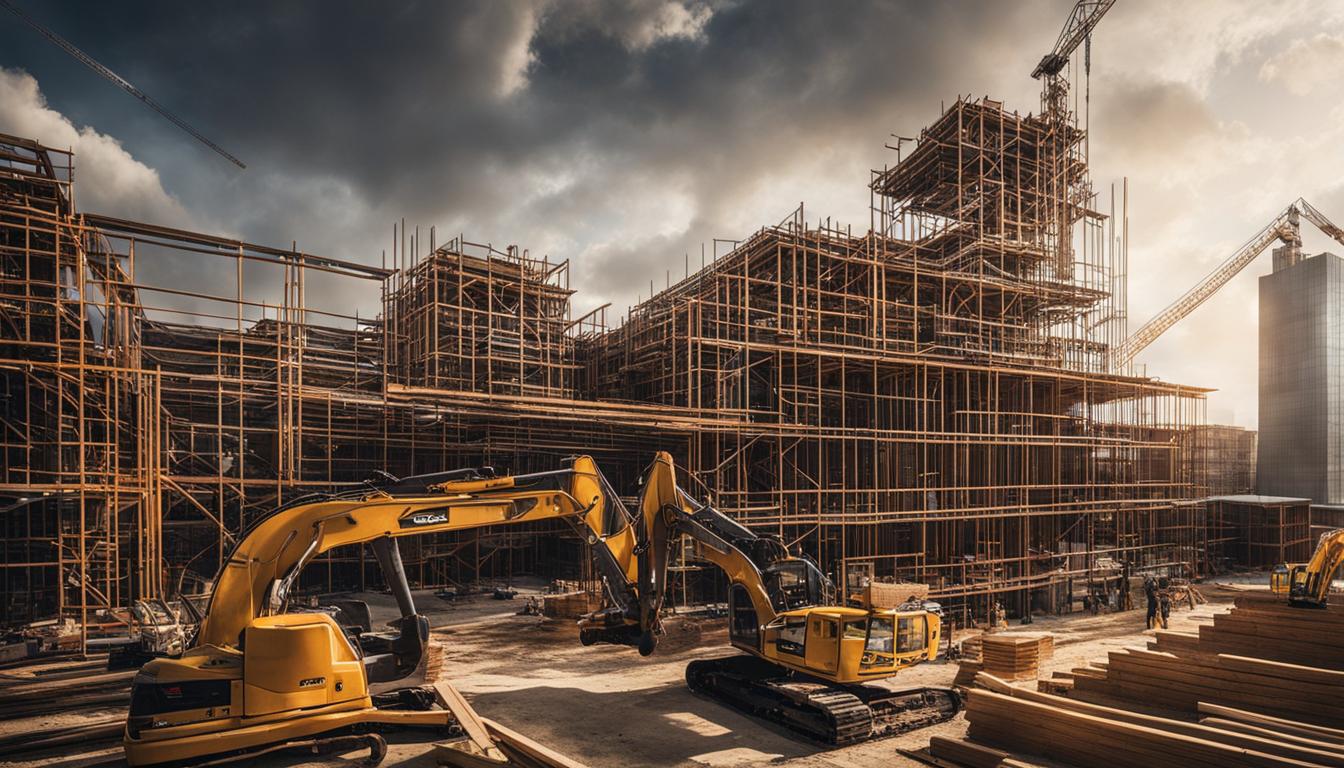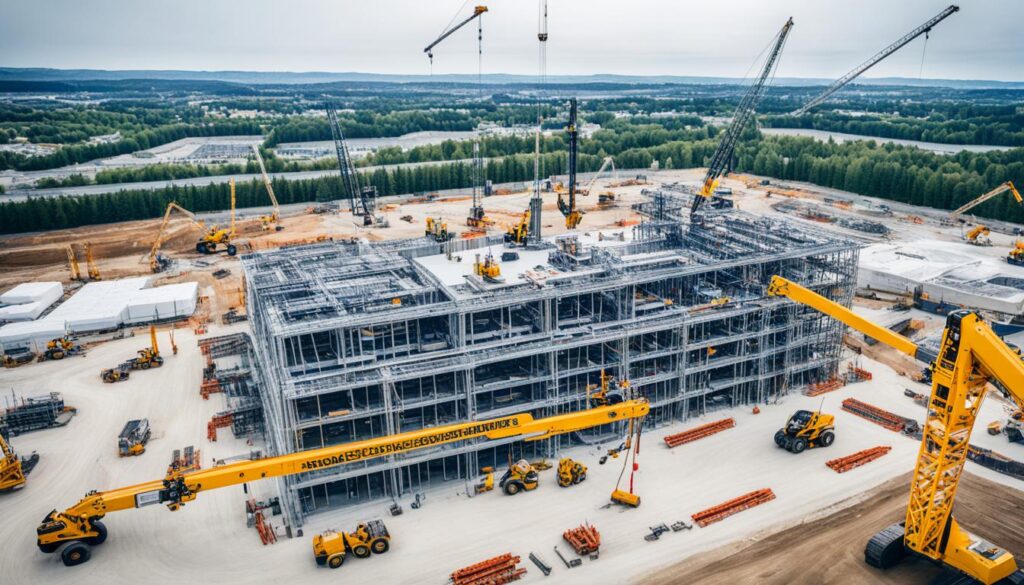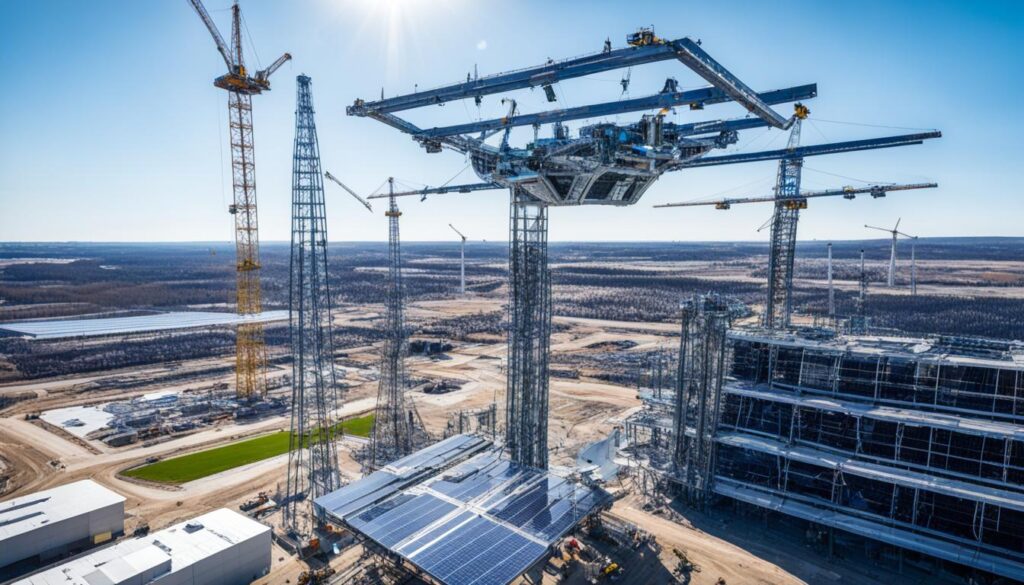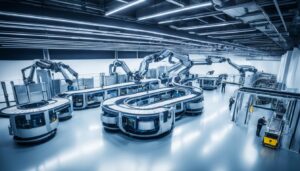
Construction technology, by definition, encompasses the collection of innovative tools, machinery, modifications, and software used during the construction phase of a project. It is designed to drive advancement, innovation, and increase efficiency in the construction industry. building technology is its own independent category of technology and has been evolving since the industrial revolution. It plays a crucial role in the industry, improving safety, budget management, project planning, and overall productivity.
Key Takeaways
- Construction technology encompasses innovative tools, machinery, modifications, and software used in construction projects.
- It drives advancement, innovation, and increases efficiency in the construction industry.
- Building technology improves safety, budget management, project planning, and overall productivity.
- The integration of digital technology and the internet has revolutionized building technology in the 21st century.
- Advancements such as fleet management systems, GPS technology, 3D printing, drones, and virtual reality have improved safety standards, streamlined project management, and increased productivity.
The Evolution and Impact of Construction Technology
Construction technology has undergone significant advancements in the 21st century, driven by the rapid development of digital technology and the widespread use of the internet. These advancements have revolutionized the construction industry, introducing modern construction technology that has reshaped traditional practices.
Various new technologies have been integrated into construction processes, enhancing safety standards, improving project management, increasing productivity, reducing waste, and promoting sustainable and green construction practices. Construction companies are increasingly adopting these technologies to stay competitive and meet the demands of modern construction projects.
Key Construction Technology Trends
- Fleet Management Systems: These technologies enable efficient management of construction vehicles, optimizing routes, monitoring fuel consumption, and improving overall fleet performance.
- GPS Technology: GPS systems allow accurate asset tracking, real-time monitoring, and efficient coordination of construction activities.
- Blockchain: Blockchain technology provides secure and transparent transactions, enhancing payment systems and supply chain management in the construction industry.
- 3D Printing: 3D printing technology enables the construction of complex structures through additive manufacturing, reducing construction time and costs.
- Autonomous Vehicles: Self-driving construction vehicles improve safety, reduce human error, and enhance efficiency in tasks such as excavation and transportation of construction materials.
- Drones: Drones are used for surveillance, project monitoring, site inspections, and data collection, providing real-time information for better decision-making.
- Robotics: Robotic tools automate repetitive tasks, increasing efficiency, precision, and safety in construction processes.
- Wearable Safety Tech: Wearable devices, such as smart helmets and safety vests, enhance worker safety by monitoring vital signs, detecting potential hazards, and providing real-time alerts.
- Site Management Software: Software applications facilitate project planning, scheduling, and collaboration, improving communication and coordination among construction teams.
- Electronic Payment Systems: Digital payment solutions streamline financial transactions, reducing paperwork and improving cash flow in construction projects.
- Virtual Reality: Virtual reality technology offers immersive simulations and visualizations, enabling virtual inspections, training, and design evaluations.
These construction technology trends have had a profound impact on the industry, transforming construction practices and improving project outcomes. They have not only enhanced safety standards but also streamlined project management processes, increased productivity, reduced waste, and enabled sustainable and environmentally-friendly construction practices.
Key Benefits of Construction Technology
The adoption of construction technology offers several benefits to the industry. Advanced construction technology has revolutionized the way construction projects are approached, resulting in improved efficiency, safety, collaboration, quality, compliance, and cost savings.
Enhanced Safety Measures
Construction technology provides tools and solutions that enhance safety measures on construction sites. Wearable technology, such as smart helmets and safety vests, can monitor vital signs and detect potential hazards, ensuring the well-being of workers. Drones equipped with cameras and sensors enable efficient site inspections, identifying potential risks without putting personnel in danger. Virtual reality technology allows for realistic and immersive training experiences, preparing workers for hazardous scenarios without exposing them to real-life dangers.
Increased Efficiency
Advanced construction technology streamlines and automates various processes, ensuring increased efficiency. Automation tools, such as robotic machinery and AI-powered systems, improve productivity by reducing manual labor and human error. 3D printing technology enables the creation of complex structures with speed and precision, eliminating the need for traditional construction techniques. Building Information Modeling (BIM) software allows for advanced planning and collaboration, optimizing construction workflows and minimizing delays.
Improved Quality
Construction technology offers tools and solutions that ensure improved quality in construction projects. Augmented reality (AR) can overlay digital information onto existing structures, enabling real-time quality checks and precise measurements. Robotic tools and machinery provide consistent and accurate results, reducing human error and enhancing the overall quality of construction work. These technologies contribute to the creation of durable and sustainable structures that meet or exceed industry standards.
Streamlined Compliance
Construction technology simplifies compliance with regulations by providing efficient document management systems and real-time notifications. Construction companies can automate the process of tracking and organizing documents, making it easier to store, retrieve, and update necessary records. Real-time notifications ensure that project teams stay informed and compliant with changing regulations, helping avoid penalties and delays.
Better Collaboration
Cloud-based project management software revolutionizes collaboration in construction projects. It provides a centralized platform where project teams can access and share information, collaborate on designs, track progress, and communicate in real-time. This enables seamless coordination across different teams, disciplines, and stakeholders, fostering effective collaboration and reducing misunderstandings or delays caused by miscommunication.
Cost Savings
Construction technology helps construction companies achieve cost savings through various means. By leveraging automation and advanced planning tools, companies can optimize resources, reduce waste, and minimize costly rework. Advanced construction techniques like prefabrication and modular construction allow for faster and more efficient construction processes, resulting in reduced labor and material costs. By adopting building technology, companies can better allocate resources and make informed decisions to optimize project budgets.
Overall, the benefits of construction technology make it a valuable investment for construction companies looking to enhance safety, efficiency, collaboration, quality, compliance, and cost-effectiveness in their projects.
Examples of Construction Technology
Construction technology encompasses various tools and technologies that have transformed the industry and continue to evolve. These advancements have greatly enhanced efficiency, productivity, and safety in construction projects. Let’s explore some of the most commonly used examples of building technology:
- Fleet Management Systems: These systems utilize GPS technology to track and manage construction vehicles, improving logistics and resource allocation.
- GPS Technology: Global Positioning System (GPS) technology enables accurate location tracking and surveying, facilitating precise construction planning and execution.
- Blockchain: Blockchain technology provides secure and transparent transaction records, enhancing supply chain management, contract management, and payment processes in construction.
- 3D Printing: 3D printing allows for the creation of intricate and customized building components, reducing construction time and costs.
- Autonomous Vehicles: Self-driving vehicles streamline construction site transportation, material delivery, and logistics, increasing efficiency and reducing manual labor.
- Drones: Drones provide aerial surveying, mapping, and inspection capabilities, improving safety, efficiency, and accuracy in construction projects.
- Robotics: Robotic technologies automate repetitive tasks, such as bricklaying or concrete pouring, increasing speed, precision, and safety.
- Wearable Safety Tech: Wearable devices, such as smart helmets or vests, monitor worker safety and health, enhancing on-site safety protocols.
- Site Management Software: Software tools streamline project management processes, including scheduling, resource allocation, and progress tracking.
- Electronic Payment Systems: Electronic payment solutions simplify financial transactions between contractors, suppliers, and clients, ensuring efficient payment processing.
- Virtual Reality: Virtual reality technology enables immersive simulations, improving design visualization, training, and collaboration during the construction phase.
These examples of construction technology represent a small fraction of the innovations happening in the industry. Emerging technologies like artificial intelligence and automation hold immense potential in further revolutionizing construction practices and addressing industry challenges.

As construction technology continues to advance, it is crucial for construction companies to stay updated and embrace these cutting-edge solutions to maintain a competitive edge and deliver successful projects.
Implementing Construction Technology
Implementing construction technology is a strategic process that requires a thorough understanding of a construction company’s specific needs and challenges. By leveraging advanced construction technology, companies can address inefficiencies and improve workflows, ultimately leading to enhanced productivity and profitability. Here are some key steps to consider when implementing construction technology:
1. Identify Areas of Improvement
Start by identifying the areas within your construction processes where technology can make a significant impact. This could include streamlining project management, improving communication and collaboration, enhancing safety measures, or optimizing resource allocation.
2. Assess Objectives and Must-Have Features
Next, assess your company’s objectives and determine the must-have features you require in a construction technology solution. Consider factors such as ease of use, scalability, data security, and integration capabilities. Align these objectives and features with the available construction technology solutions on the market.
3. Explore Integration Options
There are various construction technologies available that can be integrated into your processes to drive efficiency and improve outcomes. Some examples include:
- Building Information Modeling (BIM) software: Enables better project planning and coordination.
- Data collection apps: Simplify data capture and analysis on-site.
- Drones: Facilitate aerial surveys, inspections, and progress monitoring.
- Virtual reality: Enhance design visualization and client engagement.
- Wearables: Improve worker safety and health monitoring.
By exploring these integration options, you can find the right mix of technologies that align with your company’s goals.
4. Plan for Implementation
Once you have identified the technologies you want to implement, it is crucial to plan for a smooth transition. This may involve training employees to use the new systems, updating infrastructure to support the technology, and establishing partnerships with technology providers.
5. Stay Up-to-Date with Advancements
Construction technology is ever-evolving, with new advancements and innovations constantly emerging. To remain competitive and meet industry demands, it is essential for construction companies to stay updated with the latest developments and trends in advanced building technology. This includes attending industry conferences, participating in technology demonstrations, and engaging with relevant online communities.
By carefully implementing construction technology, construction companies can unlock the full potential of advanced tools and solutions, leading to improved efficiency, increased project success rates, and a sustainable competitive advantage in the industry.

The Future of Construction Technology
The future of the construction industry is being shaped by emerging trends and advancements in building technology. As construction companies adapt to meet the demands of the modern world, they are investing more in digital technology and exploring innovative approaches to construction projects.
One of the key trends that will shape the future of the industry is AI development in Building Information Modeling (BIM). AI-powered BIM software can revolutionize the way construction projects are planned, designed, and executed. With the ability to analyze vast amounts of data and make accurate predictions, AI-driven BIM can optimize project timelines, reduce costs, and improve overall project management.
Another trend that will have a significant impact on the industry is cloud-based collaboration. By utilizing cloud-based platforms, construction teams can streamline communication and information sharing, facilitating better collaboration between stakeholders. This results in improved project coordination, reduced errors, and increased productivity.
Modular construction is also a future trend that will drive efficiency and sustainability in the construction industry. By prefabricating building components in a controlled environment, construction companies can reduce waste, save time, and minimize disruptions on-site. Modular construction offers the potential for faster construction timelines, lower costs, and improved quality control.
It is important to note that the adoption of these new technologies goes beyond addressing current construction challenges. It also has the potential to attract future talent to the industry. As technology continues to advance, the construction industry will become an attractive sector for individuals seeking rewarding careers that blend creativity, innovation, and technological expertise.
The table below highlights the future trends shaping the construction industry:
| Trend | Impact |
|---|---|
| AI development in BIM | Optimized project timelines, reduced costs, improved project management |
| Cloud-based collaboration | Better communication, improved coordination, increased productivity |
| Modular construction | Reduced waste, faster construction timelines, enhanced quality control |
The future of the construction industry is exciting, with technology playing a crucial role in driving progress and shaping the industry’s landscape. By embracing these future trends and investing in advanced building technology, construction companies can stay competitive and lead the way in innovation.

Conclusion
Modern construction technology has transformed the construction industry, delivering a range of benefits including enhanced safety measures, improved efficiency, higher quality construction, compliance adherence, better collaboration, and significant cost savings. The integration of advanced technologies like 3D printing, drones, virtual reality, and artificial intelligence has revolutionized various aspects of construction projects.
With the incorporation of 3D printing, construction companies can create complex structures and components with precision and speed, reducing construction time and costs while maintaining high-quality standards. Drones have become essential tools for site inspections, providing real-time data and reducing human risk. Virtual reality allows construction professionals to visualize and plan projects effectively, minimizing errors and optimizing resources.
Furthermore, the implementation of artificial intelligence in building technology enables automation and data analysis, improving decision-making processes and reducing human error. These advancements have significant implications for the future of the construction industry, with emerging trends and technologies expected to drive innovation even further.
By embracing modern construction technology, construction companies can stay competitive and open new avenues for growth. Staying updated with the latest advancements and trends will be crucial for companies looking to optimize operations, enhance project outcomes, and keep pace with the evolving needs of the industry. The future of building technology holds exciting possibilities for sustainable practices, increased productivity, and the continued transformation of the construction industry.
In light of technological advancements, the labor market has experienced significant shifts, with certain sectors bearing the brunt of job losses. One area particularly impacted by technological changes is the manufacturing sector, where automation and robotics have led to the displacement of traditional manufacturing jobs. Additionally, the rise of e-commerce and digitalization has transformed the retail industry, resulting in job losses in brick-and-mortar stores. However, it’s essential to delve deeper into the data to understand which sector has lost more jobs due to technological changes and explore strategies to mitigate the impact on affected workers and industries.








